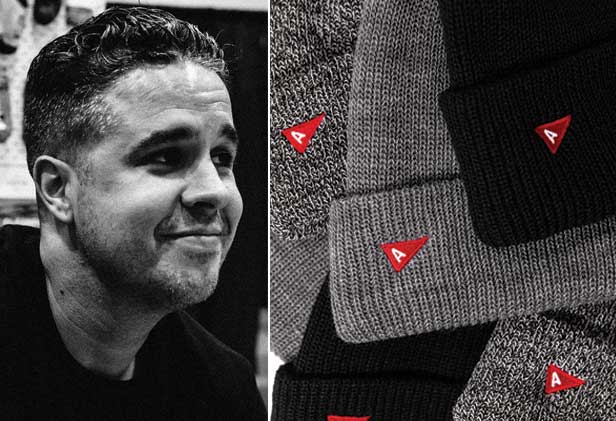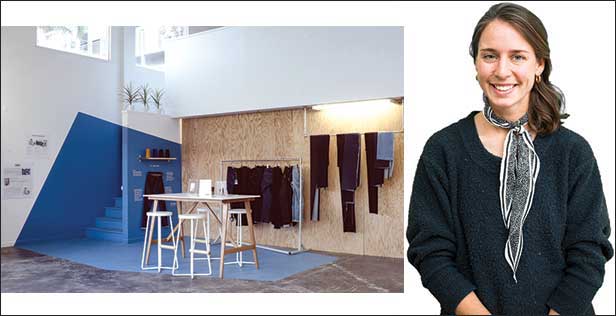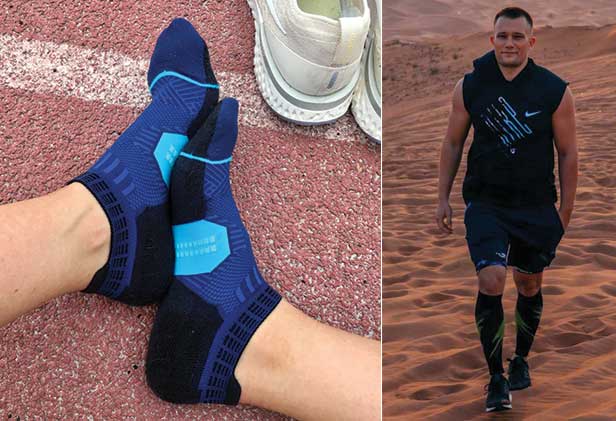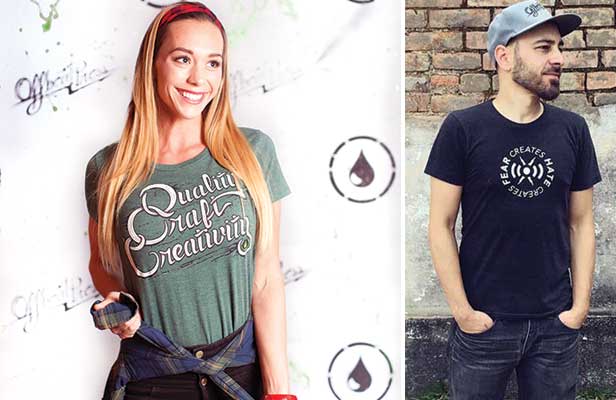May 31, 2019
Four Approaches to Sustainability
As the world’s second-largest polluter, the fashion industry has a lot of work to do, from lowering energy use and decontaminating water supplies to reducing overall waste – both at the pre- and post-consumer stage. A growing number of fashion brands and apparel decorators are working to tackle the sustainability issue, each bringing a distinct perspective to the cause. Here are profiles of four companies adopting unique approaches to promote sustainability.
From Rags to Recycled
Dustin Winegardner is on a mission to make the “cleanest basics on the planet” using cotton scraps, discarded fishing nets, plastic waste and other materials to create socks, underwear and beanies.

[At left] Dustin Winegardner, Arvin Goods; [At right] Arvin Goods makes socks, beanies and other apparel basics using recycled textiles.
Winegardner was researching sustainable materials for ITC Accessories, a Dutch manufacturing company that handles accessory supply chains for private label retail clients, when he had a lightbulb moment. “I saw a gap in the market – no one was doing these basic products using recycled materials,” he says. Out of that revelation, Arvin Goods was born, launching online in June 2017.
Arvin Goods socks are made from 50% upcycled post-industrial cotton. The other half is recycled post-consumer plastic bottles. “The combination of these two recycled materials forms a consumer-grade yarn comparable in quality and construction to any conventional cotton-poly mix,” Winegardner says. “But ours took zero water, no new dyes and no waste. We’re actually using waste as an input.”
So how does it work? Winegardner gives the example of red socks. Rather than taking conventional cotton fiber and dyeing it, Arvin Goods’ partner facility in Spain will collect cutting scraps from a factory that just sewed a big run of red T-shirts, then grind that yardage back into usable fiber.
Winegardner sees Arvin Goods as an educational tool for consumers. It’s much easier, he points out, for shoppers to stomach the $10 to $12 cost of sustainable socks, than, say, a $200 jacket made from recycled polyester. “It’s a low barrier of entry” for consumers, he says, to get that first taste of sustainably produced apparel, spurring them to make “bigger and broader decisions about the consumption of apparel.”
Winegardner also hopes to convince bigger fashion brands to use the Arvin Goods model in their own supply chains. “We’re sort of running it as an open-source project,” he says. “If someone wants to talk about it, we’ll help them. If we can influence people and change the way they’re doing this, it’s better for everybody.”
Though many brands are reluctant to invest whole-hog into a closed-loop sustainable supply chain because of the perceived cost, Winegardner hopes the example of Arvin Goods will assuage their skepticism. “You have to create this mass scale,” he says. “Once you have that scale, this raw material is not more expensive than their conventional methods.”
“A lot of people are saying that in the future one of the biggest raw materials will be recycled clothing. It will become a raw material input.” — Dustin Winegardner, Arvin Goods
Eventually, other companies may have no choice but to follow suit. “There’s data that shows we’ve already actually crossed the tipping point of how much cotton we can grow versus how much clothing is produced,” Winegardner says. “A lot of people are saying that in the future one of the biggest raw materials will be recycled clothing. It will become a raw material input.”
The ultimate goal is to be completely circular, where Arvin can take back its own goods and other worn apparel, and feed it back into the supply chain to create new basics. The textile recycling industry hasn’t reached that stage yet, but Winegardner plans to be ready when it does.
Denim Made to Order
Beth Esponnette was working for an outdoor clothing brand that encouraged people to engage with nature while at the same time contributing to its depletion. “The way they were making products and the amount of inventory they were carrying and what had to go to waste at the end of the day didn’t match what was being put out there in the world,” she says. “That frustrated me.”
Large inventories have been a big problem for apparel companies. “The way manufacturing is set up now is very much a push model,” Esponnette says. Designers have to justify making hundreds of thousands of pieces to get through production and make minimums, then guess where and when people will want to buy them.”

[At left] Denim Unspun uses 3-D body scans and an algorithm to create custom-fit jeans. The upstart brand deliberately carries no inventory to cut down on waste; [At right] Beth Esponnette, Denim Unspun
Esponnette wanted to flip that model on its head. Her company, Denim Unspun, only creates a garment after someone asks for it. “We’re eliminating inventory,” Esponnette says. “We’re reducing our impact through only making exactly what someone wants to buy and no more.”
Denim Unspun, which has a store in San Francisco and another in Hong Kong, uses 3-D body scans and an algorithm to ensure personalized fit of its custom jeans. The company takes inspiration from the way a traditional tailor operates, but saves time by using the body scans rather than having to schedule fittings and make patterns. “We’re able to speed up the process,” Esponnette says.
“We’re reducing our impact through only making exactly what someone wants to buy and no more.” — Beth Esponnette, Denim Unspun
Denim Unspun currently sources its fabric from a mill in Milan, Italy, that focuses on reducing water use and has a clean dyeing process that involves a biodegradable polymer made from recycled food waste. “I’m wary of the fact that it still has to travel halfway across the world, but they’re very good about what they do with water and not using chemicals for the dye,” Esponnette says.
The other pain point Esponnette is working to correct is in the cut-and-sew process, which still generates fabric waste. Her plan to eliminate cutting scraps is to use 3-D weaving to create garments. “You go straight from the yarn to the final product,” she says. “We’re still developing the tech.”
Cleaning the Oceans, One Sock at a Time
Daniel Chabert started Rockay to combine his two passions: running and the environment. Rockay running socks are made completely from recycled polyester, half of which is taken directly from the ocean. “Plastic is really destroying our ecosystem,” Chabert says. “It’s coming from all over the world, and it affects all of us.”
The company works with a factory in Spain that takes plastic out of the ocean and turns it into polyester fiber. “They’re finding Japanese bottles, plastic from all over the world,” Chabert says. “It doesn’t really matter where you start collecting from, the oceans are all moving.”
Chabert believes his company’s socks have a quality that rivals larger athletic brands. “You can put them on and not even think about wearing them,” he says. “You can run without constraints.”

[At left] Rockay creates running socks made from 100% recycled polyester, some of which is sourced from the ocean, in an effort to help purify the world’s water supply; [At right] Daniel Chabert, Rockay
It took some time to develop the right construction for the socks. Rockay experimented with different fabrics before hitting on the right mix of recycled fibers. According to the company website, one pair of its Accelerate running socks removes the equivalent of one plastic water bottle from the ocean. Its compression socks remove the equivalent of 3.5 water bottles.
Another way Rockay is hoping to cut down on water waste happens once the socks have been used. The company has started treating its socks with a Polygiene coating to make them odor-free, so that they don’t have to be laundered after each wear. Polygiene uses low concentrations of silver salt, recovered from recycled silver in electronic waste, to prevent bacteria from developing on textiles, so that no odor develops. “When you go for a run, the socks don’t smell,” Chabert says. “You only have to lay them out to dry.”
The ability to cut back on laundering helps to make a garment more “green.” Washing and drying accounts for about two-thirds of a product’s environmental impact, according to the Polygiene website.
Chabert says he would love to see more companies follow in Rockay’s footsteps. “We’re not doing this to sell more,” he says. “We’re doing this because somebody has to change the industry. … Nothing could be better than if all of our competitors started doing the same thing as us.”
Moving forward, Rockay hopes to expand into a full lineup of running apparel, from tights and pants to jackets and long-sleeve tees. All of it will be made from recycled materials, Chabert says. “That’s something we won’t compromise on,” he adds.
‘Lean, Mean and Green’ Printers
Jamie Dillon, owner of Print Natural in Philadelphia, doesn’t mince words when it comes to the screen-printing industry. “When you’re a screen printer, you’re basically a restaurant for plastic,” he says. “You’re churning out plastic into the world. The whole process is super-toxic: the spray adhesive, the thinners and all the stuff that you traditionally use with plastisol printing. It’s gross for human beings and the planet.”

Print Natural, a water-based screen-printing shop based in Philadelphia, strives to be eco-friendly and sustainable in its methods.
Print Natural is a water-based shop that uses only manual presses by design. The shop eschews PVCs, phthalates, discharge ink and toxic chemicals of any kind. Beyond using water-based inks, Dillon takes other steps to be sustainable, recycling and reusing as much as possible. The shop uses a water-filtration system to keep ink chunks from going down the drain. “We’re constantly cycling our inks to make colors,” he says. “We only have 20 ink colors at a time and engineer them into new colors for various jobs.” Customers are given a discount for ordering light-colored shirts instead of dark so the print won’t need to be flashed, thus saving energy.
Printing with water-based inks can be a challenge. “We do a print run, and you can’t stop printing. The press has to be moving at all times. … It’s really skill-based. You have to be a really excellent printer to keep the print looking good,” Dillon says. But, “When we decided to do custom printing, the only way I was going to do it was eco-friendly and sustainable.”
Over in Oshkosh, WI, Drew Mueske runs Offbeat Press, another water-based print shop with a focus on sustainability. “As a small business, we make a point to be conscious of every decision we make,” Mueske says.

[At left] The sustainability-focused Offbeat Press creates water-based prints like this T-shirt; [At right] Drew Mueske, Offbeat Press
Small decisions can add up to make a big impact, he says. A lot of the shop’s equipment was built in-house from repurposed materials, including the washout booth and drying cabinets. “We’ve done a lot with the local Habitat for Humanity ReStore,” Mueske says.
“As a small business, we make a point to be conscious of every decision we make.” — Drew Mueske, Offbeat Press
Offbeat Press, which has a Gold Certification from nonprofit Green America, also focuses on workflow efficiency to help reduce its footprint. The shop uses an LED-powered exposure unit to cut back on energy use and shorten screen prep time. Offbeat Press also uses low-impact chemicals during screen reclamation and shop cleaning and a water-based pallet adhesive. “We try to be lean, mean and green,” Mueske says.
THERESA HEGEL is the executive editor of Wearables. Contact: thegel@asicentral.com; follow her on Twitter at @theresahegel.

Product Hub
Find the latest in quality products, must-know trends and fresh ideas for upcoming end-buyer campaigns.